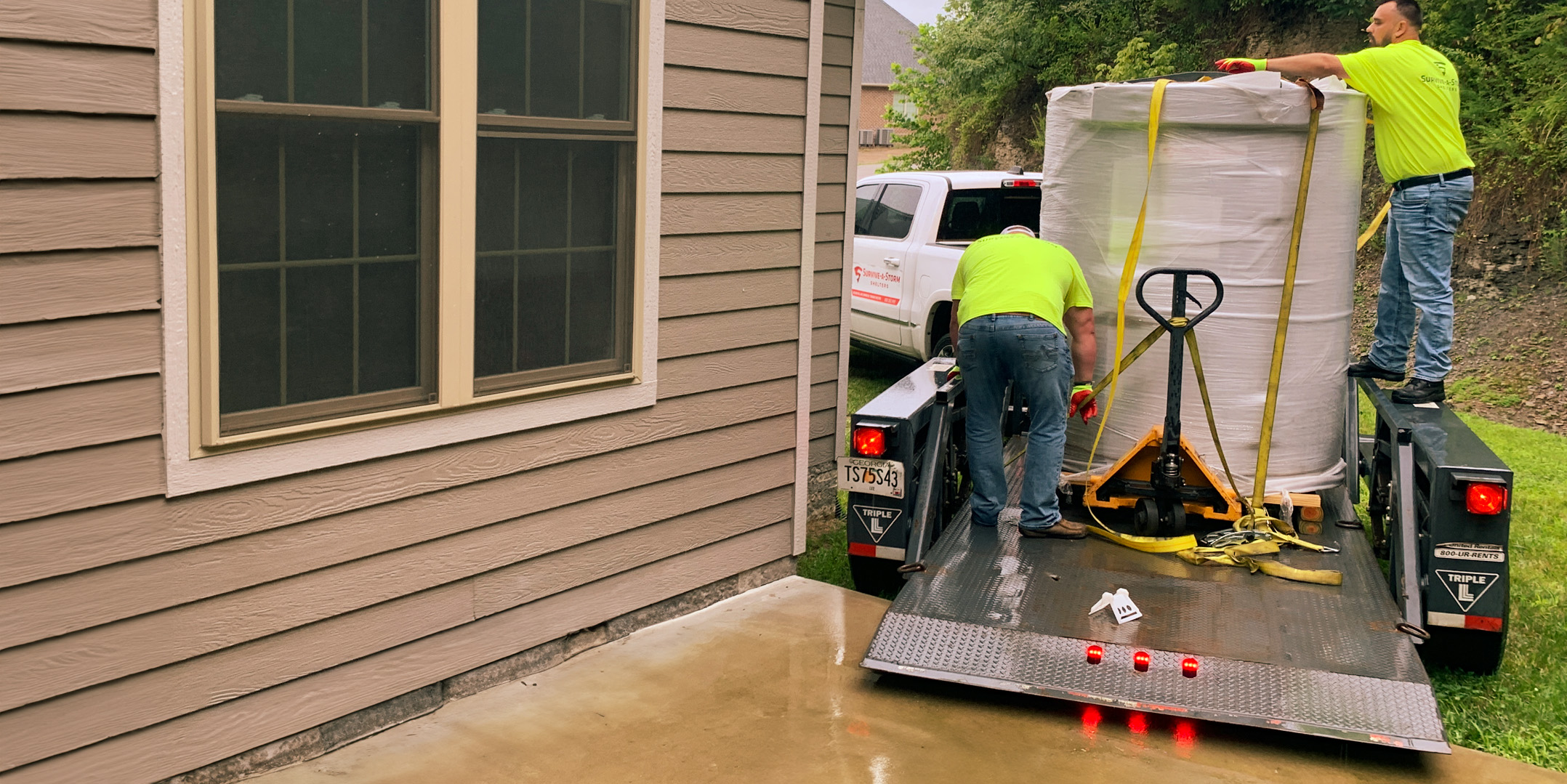CATEGORIES:
Above Ground Tornado Shelters and Relocation: What If I Move or Buy a New Home?
August 21, 2024

According to the US Census Bureau, in 2022, approximately 27.1 million people—about 8.4% of the U.S. population—moved to a new home, highlighting how the days of buying a house and staying in it for decades are becoming less common. With so many people on the move, it’s no surprise that a frequent question about our tornado shelters is if they can be relocated if/when the buyer moves.
One of the most common misconceptions about tornado shelters is that they are permanent fixtures that cannot be moved once installed. This belief can discourage homeowners from considering relocation when they move to a new home or from purchasing a storm shelter in the first place.
The good news is that for our above-ground shelters, the answer is YES, they can be moved! In addition to providing as much protection as an underground shelter and providing safety in any location, regardless of the proximity to the coastline, one of the major benefits of an above-ground tornado shelter is the ability to move it if you relocate.
If you’re moving, you can rest assured that your shelter will make the transition safely. When you buy your above-ground shelter from Survive-A-Storm Shelters, we can help you get it from point A to point B—while maintaining its integrity and effectiveness. Even in a new location, it will provide the protection you rely on when it matters most.
The most common reason for relocating an above-ground storm shelter is that the owner of the tornado shelter is moving to a new location. Whether one owns a home or not, tornado shelters are a significant investment, and leaving them behind may not be an option. Taking your storm shelter with you ensures that your new home will offer the same level of protection you’ve come to rely on.
Another scenario we have seen is that the owner of the shelter is moving to a new home that has storm protection, so they choose to gift or sell their above-ground storm shelter rather than leave it behind. In these cases, passing on your shelter to a loved one or selling it to a new owner is a practical solution.
Whatever the reason, Survive-A-Storm’s relocation services ensure that the transfer is done safely and seamlessly so you can focus on settling into your new home.
Factors to Consider Before Moving Your Above-Ground Tornado Shelter
An important factor in relocating a storm shelter is the condition of the slab where it will be placed. If the slab has post-tension cabling, which is a common reinforcement method, the location of the cabling needs to be determined so that it can be avoided when the installation is done. If the presence of post-tension cabling is unknown, the customer will need to have the slab scanned by a third-party professional to determine that and identify the locations of cables to be avoided.
If the new location does not have a suitable slab, a new one will need to be poured according to the specifications of the shelter. This ensures the shelter is again securely anchored and structurally sound in its new position. Our team at Survive-A-Storm can provide guidance on the proper specifications for the slab based on the type and model of tornado shelter.
Different models of storm shelters require different approaches to relocation. For example, our Panelized Tornado Shelters must be disassembled before they can be moved. On the other hand, models like the TwisterPod and the Extreme can simply be unbolted, moved, and re-installed with new anchors.
Another consideration when relocating your storm shelter is the potential need for permits in your new location. Some localities require permits for installing storm shelters, even if it’s a relocation rather than a new installation. Be sure that all necessary permits are obtained before the relocation takes place. This proactive approach helps prevent delays and ensures your shelter complies with local regulations.
How to Move an Above-Ground Tornado Shelter
The first step in relocating your tornado shelter is reaching out to the Survive-A-Storm sales or logistics department. Our team will work closely with you to gather all the necessary details, including the current and future locations of the shelter, as well as the specific model you own. This information allows us to provide you with an accurate quote for the relocation.
Once we have all the details, we’ll calculate the cost of the move. The quote is based on factors such as the distance between the current and new locations and the specific shelter model. Whether you’re moving across town or to a different state, we’ll ensure that the quote reflects the exact needs of your situation.
After you’ve received your quote and are ready to proceed, the next step is scheduling the relocation. Our team will coordinate with you to set a date that works best for you. Typically, the relocation process is completed in one day, with the shelter removed from the old location and installed at the new one on the same day.
On the day of the move, our factory-trained technicians will arrive at your current location to carefully uninstall the shelter. Depending on the model, the process may involve unbolting the shelter from its current position or disassembling it if you have a panelized shelter. Our team is experienced with NSSA-approved shelters and will handle it carefully to avoid damage during removal and in transit.
Once the shelter has been safely transported to the new location, our team will reinstall it according to the tornado shelter's specifications. This includes using completely new anchors to secure the shelter in its new position, ensuring that it remains as safe and secure as it was in its original location.
How Much Does It Cost to Relocate a Tornado Shelter?
The cost of relocating a tornado shelter can vary depending on the size of the shelter and the distance it needs to be moved. For smaller Survive-A-Storm Shelters, relocation costs typically start close to $800, not including mileage. Relocation for our mid-sized shelters will be closer to $1,000, plus mileage. Lastly, relocation for our largest above-ground shelters will be in the neighborhood of $1,500, plus mileage.
Mileage is the biggest unknown in the final cost, so once the team determines the distance between locations, they can provide a detailed quote based on your specific situation, ensuring transparency and accuracy.
What’s the Lead Time to Move a Tornado Shelter?
When planning to relocate your shelter, it’s essential to factor in the lead time. At Survive-A-Storm, we typically have a lead time of around four weeks for relocation projects. This allows us to coordinate all aspects of the move, like scheduling the appropriate technicians.
The lead time may vary depending on factors such as seasonal demand or your specific location. We recommend contacting us as soon as you know you want to relocate your shelter to avoid any last-minute stress. This proactive approach ensures we can accommodate your schedule and complete the relocation smoothly.
Other Considerations for Tornado Shelter Relocation
Relocating your above-ground tornado shelter is a significant event, but it’s just as important to remember the administrative side of things. After your shelter has been safely moved to its new location, it’s essential to update your warranty records, which means submitting new photos of the shelter in its new location. This will ensure your warranty remains valid and up-to-date if you ever need to make a warranty claim.
Your shelter’s registered address is crucial for several reasons. First, it allows us to provide you with timely service and support should you need it. But, more importantly, it ensures that our shelter locator service, StormRespond, can accurately identify the location of your shelter in case of an emergency. StormRespond is part of our StormWarn program, an alert service that alerts you when it is time to take shelter at your home. StormRespond is included with all Survive-A-Storm shelters and is designed to help first responders locate your shelter quickly when a storm has caused damage in your area. By updating your address with us, you help us keep this vital information current and effective.
The Reality of Moving Your Tornado Shelter
As the post has illustrated, relocation is entirely possible, AND it’s a service that many of our customers have taken advantage of over the years. Whether you’re moving to a new house, gifting your shelter, or selling it to a new owner, relocation allows you to continue benefiting from your investment without leaving it behind.
By clarifying this common misconception, we hope to encourage more homeowners to consider the flexibility and long-term value of owning an above-ground storm shelter.
If you’d like to start planning your Survive-A-Storm tornado shelter relocation, reach out to us today. We’ll make sure your relocation is as smooth as possible.




